
The Northrop GrummanEA-6B Prowler is a twin-engine, four-seat, mid-wing electronic-warfare aircraft derived from the A-6 Intruder airframe. The EA-6A was the initial electronic warfare version of the A-6 used by the United States Marine Corps and United States Navy; it was used during the Vietnam War. Development on the more advanced EA-6B began in 1966. An EA-6B aircrew consisted of one pilot and three Electronic Countermeasures Officers, though it was not uncommon for only two ECMOs to be used on missions. It was capable of carrying and firing anti-radiation missiles (ARMs), such as the AGM-88 HARM.
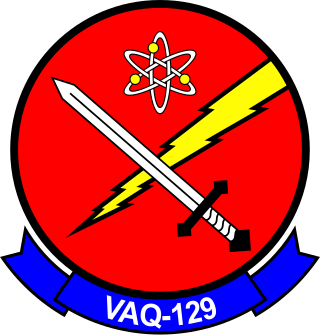
Electronic Attack Squadron 129 (VAQ-129) is the United States Navy's only EA-18G Growler training squadron. Known as the "Vikings", they are a Fleet Replacement Squadron, or FRS, and are charged with training all EA-18G aviators and developing standard operating procedures for the maintenance and operation of the aircraft. The squadron is permanently stationed at Naval Air Station Whidbey Island, in Puget Sound, Washington.
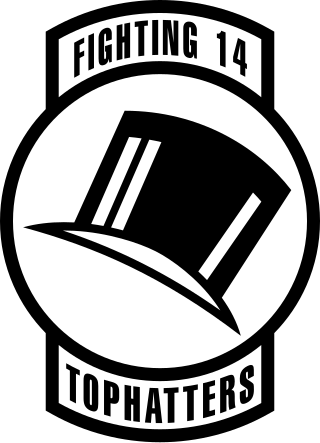
The Strike Fighter Squadron 14 (VFA-14) "Tophatters" are a United States Navy fighter attack squadron based at Naval Air Station Lemoore. They fly the F/A-18E Super Hornet, and are the Navy's oldest active squadron, having formed in 1919. Their callsign is Camelot, and their tail code is NG.

Electronic Attack Squadron 135 (VAQ-135), known as the "Black Ravens", is a United States Navy electronic attack squadron that currently operates the EA-18G Growler carrier-based electronic warfare jet aircraft. The squadron is permanently stationed at Naval Air Station Whidbey Island with a radio callsign of "Thunder".

Electromagnetic Attack Squadron ONE FOUR ZERO (VAQ-140) is a US Navy electromagnetic attack squadron. Known as the "Patriots", the squadron operates the EA-18G Growler. The squadron is home ported at NAS Whidbey Island, Washington. They are attached to Carrier Air Wing Seven, and deploy aboard USS George H W Bush. The squadron's radio callsign is "Talon" and are formally recognized as America's Squadron. Their aircrew commonly reference the rallying cry of "Glizzy Roll" in honor of their traditional ready room hot dog roller. Their mascot is their newest aircrew dressing as Evel Knievel.

Electromagnetic Attack Squadron 137 (VAQ-137) also known as the "Rooks", is a United States Navy electromagnetic attack squadron based at Naval Air Station Whidbey Island Washington, flying the Boeing EA-18G Growler. The squadron is attached to Carrier Air Wing 11 (CVW-11), which is currently assigned to USS Theodore Roosevelt (CVN-71). Their radio callsign is "Rook" and their tailcode is "NH" of CVW-11.
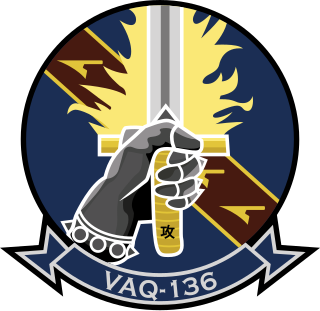
Electronic Attack Squadron 136 (VAQ-136) "Gauntlets" is a United States Navy Electronic attack squadron flying the EA-18G Growler and is currently attached to Carrier Air Wing Two, deploy aboard the aircraft carrier USS Carl Vinson a composite unit made up of a wide array of aircraft performing a variety of combat and support missions including F2T2EA. The squadron is currently stationed at Naval Air Station Whidbey Island.

A carrier air wing is an operational naval aviation organization composed of several aircraft squadrons and detachments of various types of fixed-wing and rotary-wing aircraft. Organized, equipped and trained to conduct modern US Navy carrier air operations while embarked aboard aircraft carriers, the various squadrons in an air wing have different but complementary missions, and provide most of the striking power and electronic warfare capabilities of a carrier battle group (CVBG). While the CVBG term is still used by other nations, the CVBG in US parlance is now known as a carrier strike group (CSG).
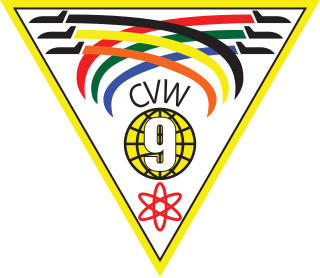
Carrier Air Wing Nine (CVW-9) is a United States Navy aircraft carrier air wing based at Naval Air Station Lemoore. The Air Wing is currently assigned to the aircraft carrier USS Abraham Lincoln (CVN-72). The Tail Code of aircraft assigned to CVW-9 is NG.

Carrier Air Wing Eight (CVW-8), is a United States Navy aircraft carrier air wing based at Naval Air Station Oceana, Virginia. The air wing is attached to the aircraft carrier USS Gerald R. Ford (CVN-78)

Carrier Air Wing Seventeen (CVW-17), is a United States Navy aircraft carrier air wing based at Naval Air Station Lemoore, California. The air wing is attached to the aircraft carrier USS Nimitz.
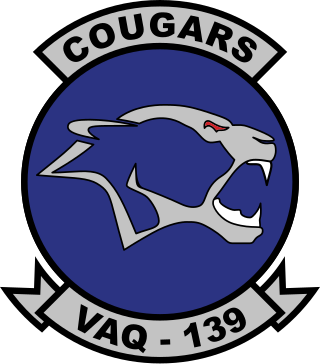
Electromagnetic Attack Squadron 139 (VAQ-139), also known as the "Cougars", is an EA-18G Growler squadron of the United States Navy. They specialize in electromagnetic attack and are currently stationed at Naval Air Station Whidbey Island, Washington. Part of Carrier Air Wing Seventeen, the Cougars deploy aboard the aircraft carrier USS Nimitz
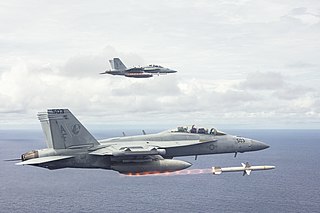
Electronic Attack Squadron 209 (VAQ-209) is a United States Navy Reserve electromagnetic attack squadron. Known as the "Star Warriors", the squadron flies the EA-18G Growler carrier-based electronic warfare jet aircraft. It is assigned to the Tactical Support Wing and based at Naval Air Station Whidbey Island, Washington. Its mission is: "To safely train to attain and maintain mobilization readiness for immediate employment in event of war or national emergency."

Helicopter Sea Combat Squadron SIX (HSC-6), is a helicopter squadron of the United States Navy. It was established as Helicopter Antisubmarine Squadron SIX (HS-6) on 1 June 1956. Its nickname is Screamin’ Indians. On 8 July 2011 it was redesignated Helicopter Sea Combat Squadron SIX (HSC-6). It is based at Naval Air Station North Island, is part of Carrier Air Wing 17 and deploys aboard the aircraft carrier USS Nimitz (CVN-68).

Electromagnetic Attack Squadron 130 (VAQ-130), also known as the "Zappers", is an EA-18G Growler squadron of the United States Navy based aboard Naval Air Station Whidbey Island. Part of Carrier Air Wing 3, the Zappers deploy aboard the aircraft carrier USS Dwight D. Eisenhower. VAQ-130 is the oldest electromagnetic warfare squadron in the U.S. Navy.

Electromagnetic Attack Squadron 131 (VAQ-131), also known as the "Lancers," is a United States Navy tactical jet aircraft squadron specializing in kinetic and non-kinetic Suppression of Enemy Air Defenses (SEAD). They are based at Naval Air Station Whidbey Island, flying the EA-18G Growler. Their radio callsign is "Skybolt."

Electromagnetic Attack Squadron 132 (VAQ-132), the "Scorpions", is a United States Navy aircraft squadron based at Naval Air Station Whidbey Island, flying the EA-18G Growler. The squadron's radio callsign is "Scorp".

Electronic Attack Squadron 134 (VAQ-134) is an electromagnetic warfare squadron of the United States Navy. It is nicknamed "Garudas" and is based at Naval Air Station Whidbey Island, Washington. The squadron is currently equipped with the Boeing EA-18G Growler.
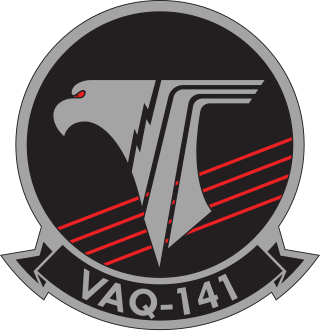
Electromagnetic Attack Squadron 141 (VAQ-141), also known as the "Shadowhawks", is an EA-18G Growler squadron of the United States Navy that is based at Marine Corps Air Station Iwakuni, located in Iwakuni, Yamaguchi, Japan. VAQ-141 falls under the cognizance of Commander, Electromagnetic Attack Wing Pacific (COMVAQWINGPAC) and flies in support of Carrier Air Wing 5 (CVW-5) aboard the Nimitz-class aircraft carrier, USS Ronald Reagan (CVN-76).

Electronic Attack Squadron 138 (VAQ-138), also known as the "Yellow Jackets", is an expeditionary EA-18G Growler squadron of the United States Navy based at Naval Air Station Whidbey Island, Washington.
























